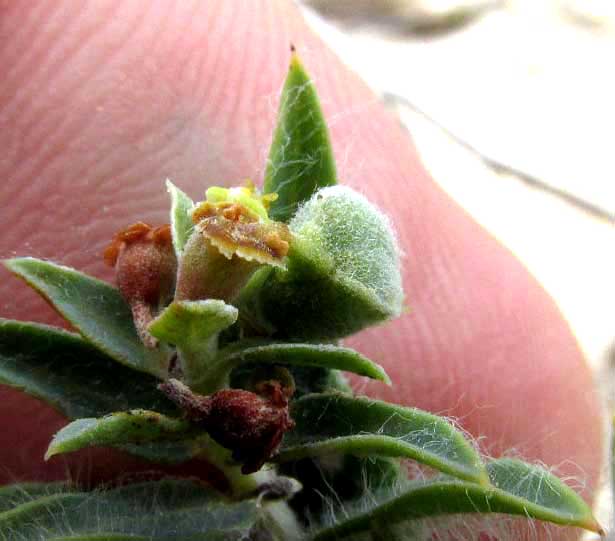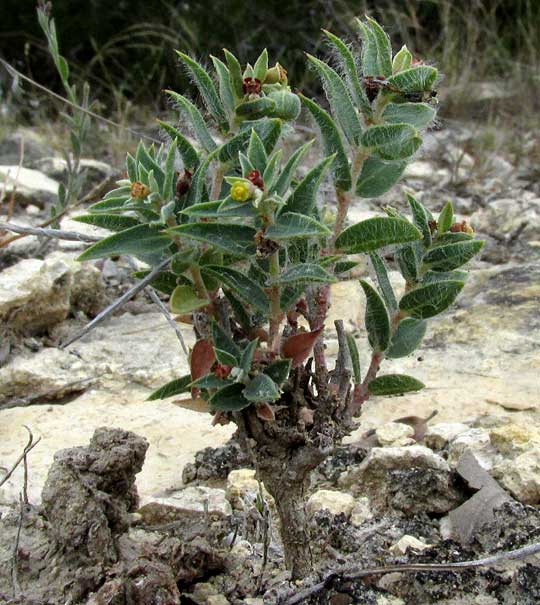Excerpts from Jim Conrad's
Naturalist Newsletter

from the August 24, 2014 Newsletter issued from the Frio Canyon Nature Education Center in the valley of the Dry Frio River in northern Uvalde County, southwestern Texas, on the southern border of the Edwards Plateau; elevation ~1750m (~5750 ft); N29.62°, W99.86°; USA
POINTED SANDMAT
During the hottest, driest days of summer, in the middle of a severe, multi-year drought, and issuing from little more than a narrow crack in limestone at the edge of a low roadcut, an ankle-high shrublet not only looked like it was thriving, but it was even flowering. Below, you can see the tough little being at the edge of its roadcut, in a habitat so severe that its only macroscopic neighbor is the scale-like, brown Dermatocarpon lichen in the background:

A closer view shows the plant's stems sprouting from a single woody-looking trunk. Remembering that the plant is only ankle high, the greenish-yellow flowers and immature green fruits seem oversized, reminiscent of a bonzai, as seen below:

A close-up of its unusual and diagnostic flower structure is shown at the top of this page.
Most folks who pay close attention to wildflowers will instantly recognize what's shown in the center of that picture as a classic example of the flowering strategy of the group of plants known as spurges -- members of the Spurge Family, the Euphorbiaceae. The thing to see in that picture is that, a little left-of-center, there's a rosy-green, cup-shaped structure with toothed, yellowish structures along its rim where petals might be expected in a flower. The cup-like thing is called a cyathium. Inside the cyathium there are several much reduced male flowers consisting of nothing more than a single stamen on a short stem, or pedicel. Amidst these male flowers, a single female flower's pedicel expands and curves over the cyathium's rim until it entirely repositions the green, whitish-hairy ovary -- the future fruit -- to outside the cyathium. In the picture you see the fruit hanging on its curved pedicel at the right of the cyathium.
So, this is a spurge , which means it's the genus Euphorbia, or -- if you believe in the existence of the genus Chamaesyce -- Chamaesyce. With recent genetic sequencing, most specialists now say that species earlier assigned to Chamaesyce actually are Euphorbias, so we'll call it a Euphorbia.
But, which Euphorbia? This one with its woody-like stem and exceptionally long hairs is unlike any I've ever seen. However, finding such an idiosyncratic plant is not a big surprise, since Euphorbia is the fourth largest genus of all flowering plants. The genus manifests itself in an incredible array of physical forms, and quite a number of species can be expected in our area. We've already profiled four from here in the Dry Frio Valley.
Unfortunately, the Flora of North America doesn't have its Euphorbia section ready yet. However, lately I've been in contact with noted Texas Botanist Bill Carr, and since he includes the word "spurge" in his email address, I figured he might not mind taking a look at the pictures. They were shipped to him, and he quickly replied: "Why that's Euphorbia acuta (Chamaesyce acuta, if you prefer), one of the most beautiful plants of the western hemisphere. It turns up from time to time on dry sunny limestone outcrops in that part of the world, but it's always a treat to see."
Isn't it wonderful to know people who recognize beautiful things when they see them?
EUPHORBIA ACUTA is sometimes known as the Pointed Sandmat, and in some literature its binomial is given as Euphorbia georgei. It grows only in southwestern Texas, southern New Mexico, and adjacent Mexico. Not much is known about it, but I suspect it's restricted to limestone, and is wonderfully drought resistant. Our plant seems to have been grazed on by animals, but it recovered nicely, actually growing into "one of the most beautiful plants of the western hemisphere."